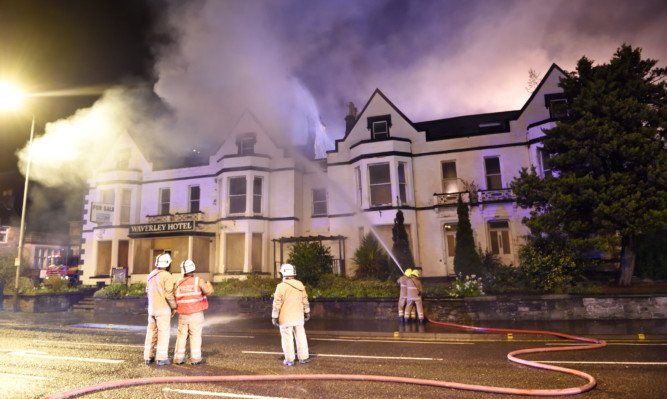Two teenagers have been accused of setting fire to a derelict hotel owned by Stagecoach tycoon Ann Gloag.
James McCrory, 18, and a 17-year-old youth who cannot be identified for legal reasons, appeared in private at Perth.
They appeared on a petition alleging they deliberately set fire to the Waverley Hotel in Perth on November 17.
The pair, both from Perth, are alleged to have caused damage to the vacant city centre building by setting it ablaze.
Neither made any plea or declaration and the case against them was continued for further examination by Sheriff Kevin Veal. Both were granted bail.
The Waverley Hotel has been derelict for several years and Mrs Gloag recently had a bid to pull it down rejected by Historic Scotland.
During the summer, Historic Scotland outlined its reasons for the organisation’s opposition to the demolition of one of Perth’s best-known former hotels.
Historic Scotland’s senior heritage management officer of historicbuildings, north, Simon Montgomery, made it clear it is strongly opposed to Mrs Gloag’s plans for the site.
He contacted Perth and Kinross Council to oppose the wealthy transport supremo’s plan to raze the Waverley Hotel and build a multi-use hall and gym in its place.
Her aim was to extend the community use of the adjacent Trinity Church of the Nazarene, stating this would assist those with drug and alcohol issues.
However, Mr Montgomery stated the preferred choice of Historic Scotland was not to demolish the building of the former Waverley Hotel.
He said: “We note that whilst the agent states the retention of one of the villas would be illogical, we would, in terms of the special interest of allthe individual buildings and theircontribution to the character of the conservation area, suggest thatretention is desirable for any of thelisted buildings.
“The structural survey’s recommendations do not provide sufficientreassurance that development of the site using the existing villas is simply notfeasible. There are no new crackpatterns or obvious movements evident.”
At the time, a spokesman for Ann Gloag said: “We are disappointed by Historic Scotland’s response, that they seek to protect redundant buildings of limited significance at the expense of local community benefit.”
